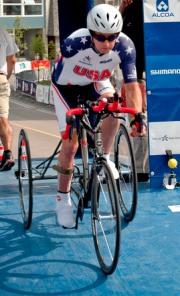Related images
(click to enlarge)

University of Washington
The hand moves the computer mouse, but the cursor doesn't comply. The cursor doesn't go where told. The hand tries again. The cursor shoots past the intended target.
The hand tries a third time – and the cursor loops farther from the target than where it started. And the user is frustrated.
So it often goes for computer users whose motor disabilities prevent them from easily using a mouse.
As the population ages, more people are having trouble with motor control, but a University of Washington team has invented two mouse cursors that make clicking targets a whole lot easier. And neither requires additional computer hardware – just some free, downloadable software. The researchers hope that in exchange for the software, users offer feedback.
The Pointing Magnifier combines an area cursor with visual and motor magnification, reducing need for fine, precise pointing. The UW's
AIM Research Group, which invented the Pointing Magnifier, learned that users can much more easily acquire targets, even small ones, 23 percent faster with the Pointing Magnifier.
The magnifier runs on Windows-based computer systems. It replaces the conventional cursor with a larger, circular cursor that can be made even larger for users who have less motor control. To acquire a target, the user places the large cursor somewhere over the target, and clicks. The Pointing Magnifier then magnifies everything under that circular area until it fills the screen, making even tiny targets large. The user then clicks with a point cursor inside that magnified area, acquiring the target. Although the Pointing Magnifier requires two clicks, it's much easier to use than a conventional mouse, which can require many clicks to connect with a target.
Screen magnifiers for people with visual impairments have been around a long time, but such magnifiers affect only the size of screen pixels, not the motor space in which users act, thus offering no benefit to users with motor impairments. The Pointing Magnifier enlarges both visual and motor space.
Software for the Pointing Magnifier includes a control panel that allows the user to adjust color, transparency level, magnification factor, and area cursor size. User preferences are saved when the application is closed. Keyboard shortcuts quickly enable or disable the Pointing Magnifier. The UW team is also making shortcuts customizable.
"It's less expensive to create computer solutions for people who have disabilities if you focus on software rather than specialized hardware, and software is usually easier to procure than hardware," said Jacob O. Wobbrock, an assistant professor in the Information School who leads the AIM Group.
His group's paper on enhanced area cursors, including the Pointing Magnifier, was presented at the 2010 User Interface Software and Technology symposium in New York. A follow-on paper will be presented at a similar conference in May.
Another AIM technology, the
Angle Mouse, similarly helps people with disabilities. Like the Pointing Magnifier, it may be
downloaded, and
two videos, one for general audiences and another for academic ones, are available as well.
When the Angle Mouse cursor initially blasts towards a target, the spread of movement angles, even for people with motor impairments, tends to be narrow, so the Angle Mouse keeps the cursor moving fast. However, when the cursor nears its target and the user tries to land, the angles formed by movements diverge sharply, so the Angle Mouse slows the cursor, enlarges motor space and makes the target easier to get into. The more trouble a user has, the larger the target will be made in motor space. (The target's visual appearance will not change.)
Wobbrock compares the Angle Mouse to a race car. "On a straightaway, when the path is open, the car whips along, but in a tight corner, the car slows and makes a series of precise corrections, ensuring its accuracy."
A study of the Angle Mouse included 16 people, half of whom had motor impairments. The Angle Mouse improved motor-impaired pointing performance by 10 percent over the regular Windows™ default mouse and 11 percent over sticky icons – an earlier innovation in which targets slow the cursor when it is inside them.
"Pointing is an essential part of using a computer, but it can be quite difficult and time consuming if dexterity is a problem," Wobbrock said. "Even shaving one second off each time a person points may save hours over the course of a year." Wobbrock suggests that users try both the Pointing Magnifier and the Angle Mouse before deciding which they prefer.
"Our cursors make ubiquitous mice, touchpads, and trackballs more effective for people with motor impairments without requiring new, custom hardware," Wobbrock said. "We're achieving accessibility by improving devices that computer users already have. Making computers friendlier for everyone is the whole point of our work."


 World-class events and activities—the perfect complement to exhibits and education—make for three days of non-stop entertainment. There are adaptive sports, dance performances, gravity-defying stunts, technology showcases, canine assistance demos and much more. You can get involved or sit back and enjoy.
World-class events and activities—the perfect complement to exhibits and education—make for three days of non-stop entertainment. There are adaptive sports, dance performances, gravity-defying stunts, technology showcases, canine assistance demos and much more. You can get involved or sit back and enjoy. 
